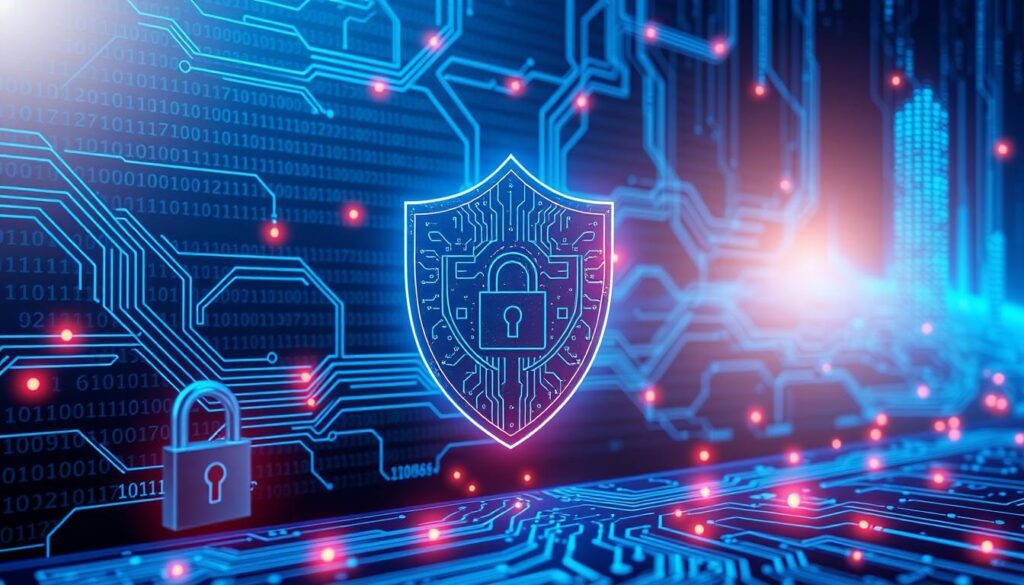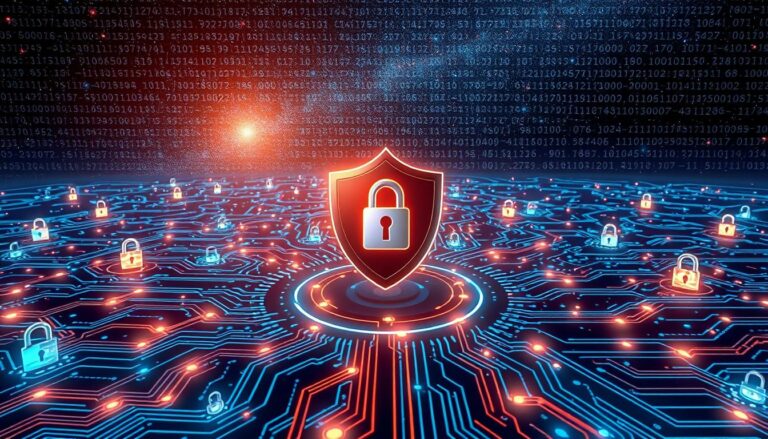Cybersecurity is key to our digital lives. It’s vital to understand it to stay safe from cyber threats. In today’s world, digital security is not just a luxury but a must. Cyber threats and nuances of cybersecurity are getting smarter, making digital security a big deal for everyone. Cybersecurity is crucial for keeping our personal and work data safe from harm.
Exploring cybersecurity means seeing how threats have changed and the need for strong digital defenses. By learning about modern cybersecurity and staying up-to-date on threats, we can protect ourselves and our groups from attacks.
Understanding the Nuances of Cybersecurity in Today’s Digital World
Cybersecurity is always changing, with new threats popping up every day. It’s key to know how to protect ourselves online. Recently, cyber attacks have gone up, showing we need strong security.
New threats mean we need better security. Firewalls and antivirus aren’t enough anymore. We must keep up with the latest security tips to stay safe.
The Evolution of Cyber Threats: nuances of cybersecurity
Cyber threats are getting smarter, with attackers using tricks to get our info. It’s vital to know how to keep our info safe. This includes managing passwords and being careful online.
Why Traditional Security Measures Are No Longer Enough
Old security tools like firewalls and antivirus aren’t enough anymore. We need new measures like encryption and multi-factor authentication. These help keep us safe online.
The Role of Human Behavior in Security: nuances of cybersecurity
People are often the biggest risk in security. It’s important to teach everyone about staying safe online. This includes using strong passwords and being careful when browsing.

- Use strong, unique passwords for all accounts
- Turn on multi-factor authentication when you can
- Keep your software and operating systems updated
- Be careful with links and attachments from unknown sources
Core Components of Modern Cybersecurity Architecture
Modern cybersecurity architecture is built on several key components. These work together to protect networks, systems, and data from cyber threats. Firewalls, intrusion detection systems, and encryption are crucial for effective cybersecurity. They help ensure strong data protection and network security.
Some key elements of modern cybersecurity architecture include:
- Firewalls to block unauthorized access
- Intrusion detection systems to identify potential threats
- Encryption to secure data in transit and at rest
These components are vital for a strong cybersecurity posture. They help protect against evolving threats.
Cloud security, artificial intelligence, and machine learning are also key. These technologies help detect and respond to threats better. They enable organizations to implement more robust cybersecurity measures. This improves data protection and network security.
Effective cybersecurity architecture needs a comprehensive approach. It must include multiple layers of protection. By using strong cybersecurity measures, organizations can safeguard their networks, systems, and data. This ensures the confidentiality, integrity, and availability of their assets.
| Component | Description |
|---|---|
| Firewalls | Block unauthorized access to networks and systems |
| Intrusion Detection Systems | Identify potential threats and alert security teams |
| Encryption | Secure data in transit and at rest |
Digital Threat Landscapes and Attack Vectors – nuances of cybersecurity
The digital world is always changing, with new cyber threats popping up daily. To keep safe, it’s key to know the usual attack ways and new threats. This means using tools like firewalls, antivirus, and security protocols like encryption and two-factor auth.
Common attacks include phishing, ransomware, and social engineering tricks. To fight these, people and companies need strong security protocols and to keep up with cyber threats. This means updating software, using strong passwords, and being careful with links and attachments from unknown sources.
By knowing the digital threat scene and taking steps to protect against cyber threats, we can lower the chance of an attack. This includes using online protection tools, staying updated on new threats, and checking and updating security protocols often.
| Attack Methodology | Description |
|---|---|
| Phishing | Trying to trick people into sharing sensitive info |
| Ransomware | Encrypting data and asking for payment to unlock it |
| Social Engineering | Getting people to share sensitive info or do certain actions |
Essential Security Protocols and Best Practices
Protecting ourselves and our organizations from cyber threats is key. This means using data protection through encryption, managing passwords securely, and using multi-factor authentication. By doing these things every day, we can lower the chance of a cyber attack.
Having a good plan for when a security breach happens is important. This plan should cover how to handle a breach, including disaster recovery steps. Being ready helps us deal with cyber attacks better and keeps our business running.
Some important security steps and best practices are:
- Keep software and operating systems up to date with the latest security fixes
- Use strong, unique passwords for all accounts, and think about using password management tools
- Turn on multi-factor authentication whenever you can
- Make backups of important data regularly, both locally and in the cloud
By sticking to these best practices and using strong security measures, we can keep our sensitive information safe.
| Security Protocol | Description |
|---|---|
| Encryption | Converting plaintext into unreadable ciphertext to protect data |
| Multi-Factor Authentication | Requiring multiple forms of verification to access an account or system |
| Incident Response Planning | Outlining the steps to be taken in the event of a security breach |
Advanced Protection Strategies for Individual Users – nuances of cybersecurity
Cyber attacks are becoming more common, so it’s crucial for users to protect themselves online. Using strong passwords and secure login methods is key. These steps make it harder for hackers to access your personal info.
Here are some important strategies for users to follow:
- Use unique and complex passwords for each account.
- Turn on two-factor authentication whenever you can.
- Use encryption tools to keep your data safe.
- Be careful when browsing online, avoiding suspicious links and downloads.
By following these tips, users can lower their risk of cyber attacks. Using VPNs and antivirus software adds extra protection. This helps block malware and other threats.
Protecting yourself from cyber attacks needs a mix of common sense, knowledge, and the right tools. Stay updated on online threats and take steps to boost your digital security. This way, you can have a safer and more secure online experience.
Enterprise-Level Security Considerations – nuances of cybersecurity
Big companies have to deal with special challenges to keep their networks safe from cyber threats. It’s key to have strong cybersecurity measures to stop data breaches and keep data protection strong. This means using firewalls, intrusion detection systems, and encryption to protect important info.
Network security is a big part of this. It’s about keeping the network safe from bad guys trying to get in, mess with things, or steal data. Companies can use many security tools and follow best practices, like:
- Doing regular security checks and risk assessments
- Having a solid plan for when bad things happen
- Teaching employees about staying safe online
Also, companies need to watch out for insider threats and advanced persistent threats (APTs). These threats are really bad because they come from people who are supposed to be trusted. To fight these, companies can:
- Keep an eye on what users are doing and spot odd behavior
- Make sure access to the network is strict and controlled
- Teach employees about staying safe online
By focusing on cybersecurity measures, data protection, and network security, companies can lower the chance of cyber attacks. This means being ready and using both tech and people to keep things safe.
| Security Measure | Description |
|---|---|
| Firewalls | Network security systems that monitor and control incoming and outgoing traffic |
| Intrusion Detection Systems | Systems that detect and alert on potential security threats |
| Encryption | The process of converting plaintext data into unreadable ciphertext |
Conclusion: Embracing a Security-First Mindset
In today’s fast-changing digital world, having a cybersecurity-focused mindset is crucial. We’ve seen how digital security is now essential, not just a luxury. It’s key for both individuals and businesses to stay safe online.
By putting security first, we can feel more confident online. We protect our personal and work info from cyber threats. Using strong security measures and staying alert online helps us stay ahead of bad actors.
Let’s all make cybersecurity a top concern. Our efforts to improve online protection help us and everyone else. Together, we can create a safer digital world. This way, we can enjoy the digital age with confidence and peace of mind.
FAQ’s
What is cybersecurity and why is it important?
Cybersecurity protects systems, networks, and programs from digital attacks. It’s key in today’s digital world. It keeps sensitive information safe, prevents data breaches, and keeps systems running smoothly.
How have cyber threats evolved over time?
Cyber threats have grown more complex and varied. New attack methods pop up all the time. This means we must stay alert and adapt to keep up.
What are the core components of modern cybersecurity architecture?
Modern cybersecurity includes firewalls, intrusion detection systems, and encryption. It also covers cloud security and uses new tech like AI and machine learning. These tools help detect and respond to threats.
What are some common attack methodologies used by cyber criminals?
Cyber criminals use phishing, malware, and ransomware. They also do DDoS attacks and social engineering tricks like pretexting and baiting.
What are some essential security protocols and best practices for individuals and enterprises?
Key security steps include using strong passwords and multi-factor authentication. Data encryption and safe browsing are also important. Enterprises should have incident response plans and keep software up to date.
How can individual users protect themselves from cyber threats?
Users can protect themselves with advanced password and authentication methods. They should use encryption, practice safe browsing, and use VPNs and antivirus software.
What are some key enterprise-level security considerations?
Enterprises need to protect large networks and systems. They must keep sensitive data safe and defend against insider threats. They also need to fight advanced persistent threats (APTs) with strong cybersecurity measures.
